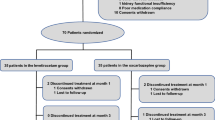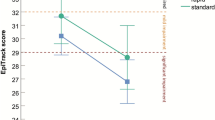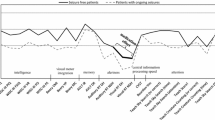Summary
The effect of an additional dose of 400 mg carbamazepine (CBZ) on a series of simple psychomotor tests was investigated in 8 patients with epilepsy receiving chronic CBZ monotherapy in a balanced randomised double-blind placebo controlled cross-over study. Psychomotor testing and blood sampling for total and free CBZ and CBZ 10,11 epoxide (CBZ-E) concentrations were performed at 10, 12, 14, 16 and 18 h after the extra dose which was administered at 23.00 h on the previous evening. The CBZ increment produced significant impairment of (i) choice reaction recognition time from 10–16 h after the dose (ii) total choice reaction time at 12 h (iii) card sorting at 12 h (iv) sedation scoring at 12 h. No significant effect on critical flicker fusion threshold, finger tapping or simple memory testing was noted. No patient reported increased side-effects in the placebo phase while 5 noted new symptoms likely to be attributable to the additional CBZ. Areas under the concentration-time curves from 10–18 h were higher following CBZ than placebo for total and free CBZ and CBZ-E concentrations. This study has demonstrated decrements in performance of a series of simple psychomotor tests in epileptic patients receiving a supplemental CBZ dose. Patients with epilepsy who require high CBZ concentrations for optimal control of seizures may be at risk of concurrent impairment of psychomotor function. Simple objective measures of performance may help in assessing the benefit-risk ratio.
Similar content being viewed by others
References
Andrewes DB, Tomlinson L, Elwes RDC, Reynolds EH (1984) The influence of carbamazepine and phenytoin on memory and other aspects of cognitive function in new referrals with epilepsy. Acta Neurol Scand 99 [Suppl]: 23–30
Brodie MJ, Forrest G, Rapeport WG (1983) Carbamazepine 10,11 epoxide concentrations in epileptics on carbamazepine alone and in combination with other anticonvulsants. Br J Clin Pharmacol 16: 747–750
Brodie MJ (1985) The optimum use of anticonvulsants. Practitioner 229: 921–927
Davidson DLW (1983) Anticonvulsant drugs. Br Med J 286: 2043–2045
Dodrill CB, Troupin AS (1977) Psychotropic effects of carbamazepine in epilepsy: A double-blind comparison with phenytoin. Neurology 27: 1023–1028
Frigerio A, Morselli PL (1975) Carbamazepine: Biotransformation. In: Penry JK, Daly DD (eds) Advances in neurology, vol 11. Raven Press, New York, pp 295–308
Hindmarch I (1980) Psychomotor function and psychoactive drugs. Br J Clin Pharmacol 10: 189–209
Hoppener RJ, Kuyer A, Meijer JWA, Hulsman J (1980) Correlation between daily fluctuations of carbamazepine serum levels and intermittent side-effects. Epilepsia 21: 341–350
Lesser RP, Pippinger CE, Luders H, Dinner DS (1984) High dose monotherapy in treatment of intractable seizures. Neurology (Cleveland) 34: 707–711
Macphee GJA, Thompson GG, Scobie G, Agnew E, Park BK, Murray T, McColl KEL, Brodie MJ (1984) Effects of cimetidine on carbamazepine auto and hetero-induction in man. Br J Clin Pharmacol 18: 411–419
Macphee GJA, Brodie MJ (1985) Carbamazepine substitution in severe partial epilepsy: Implication of auto-induction of metabolism. Postgrad Med J 61: 779–783
Macphee GJA, Goldie C, Roulston D, Potter L, Agnew E, Laidlaw J, Brodie MJ (1986) Effect of carbamazepine on psychomotor performance in naive subjects. Eur J Clin Pharm 30: 37–42
Patsalos PN, Stephenson TJ, Krishna S, Elyas AA, Lascelles PT, Wiles CM (1985) Side-effects induced by carbamazepine 10,11 epoxide. Lancet 2: 496
Riva R, Albani E, Ambrosetto G, Contin M, Cortelli P, Perucca E, Barruzi A (1984) Diurnal fluctuations in free and total steady-state plasma levels of carbamazepine and correlation with intermittent side-effects. Epilepsia 25: 476–481
Schmidt D (1983) Reduction of two drug therapy in intractable epilepsy. Epilepsia 24: 368–376
Schneider H (1975) Carbamazepine: An attempt to correlate serum levels with anti-epileptic and side-effects. In: Schneider H, Janz D, Gardner-Thorpe C, Meinardi H, Sherwin AL (eds) Clinical pharmacology of anti-epileptic drugs. Springer, Berlin Heidelberg New York Tokyo, pp 151–158
Thompson PJ, Trimble MR (1983) Anticonvulsant serum levels: Relationship to impairments of cognitive functioning. J Neurol Neurosurg Psychiatry 46: 227–233
Tomson T (1984) Interdose fluctuations in plasma carbamazepine determine intermittent side-effects. Arch Neurol 41: 830–834
Author information
Authors and Affiliations
Rights and permissions
About this article
Cite this article
Macphee, G.J.A., McPhail, E.M., Butler, E. et al. Controlled evaluation of a supplementary dose of carbamazepine on psychomotor function in epileptic patients. Eur J Clin Pharmacol 31, 195–199 (1986). https://doi.org/10.1007/BF00606658
Received:
Accepted:
Issue Date:
DOI: https://doi.org/10.1007/BF00606658




